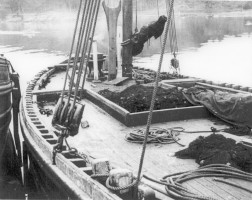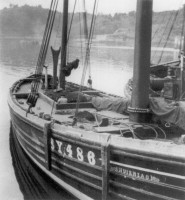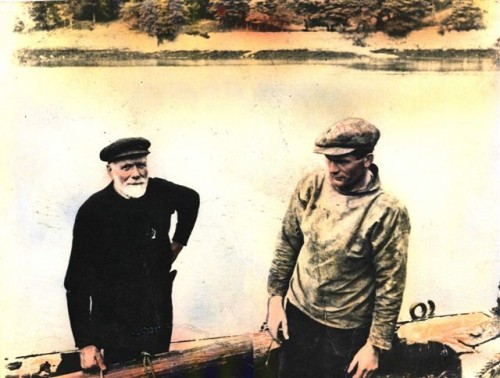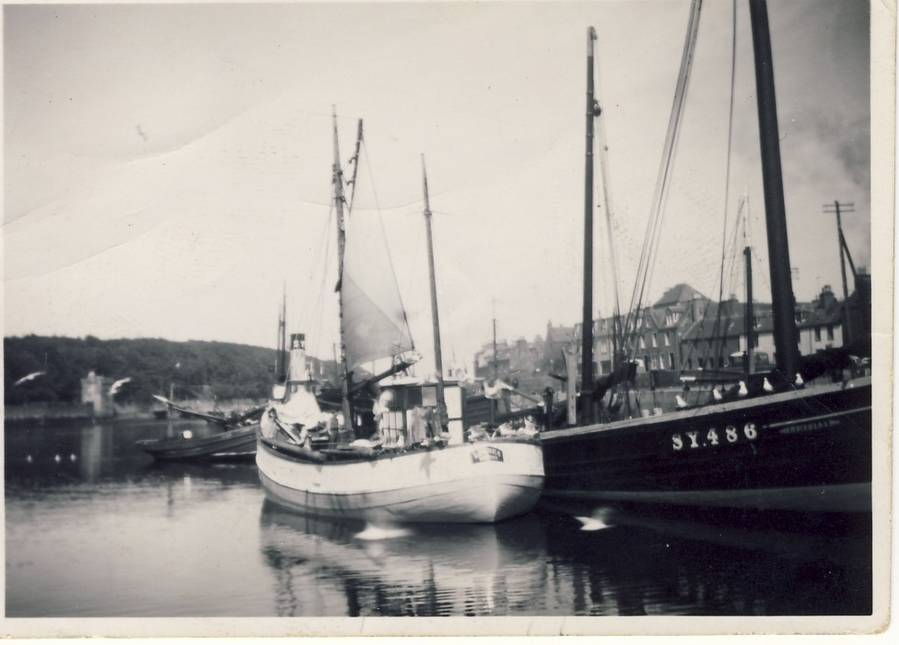
GUESTBOOK
View this page at 1024x768 This page last updated Oct 2012 NEW Oct 2012 Donald Morrison sent a link to a photo of a model of Muirneag recently built by his Dad
NEW Dec 2009 A visit to the site where the Muirneag was broken up for fenceposts.
NEW Nov 2009 A stunning color profile of the 'Muirneag' available from Kathy Bray of Bray Prints. (opposite)
Any understanding of the Muirneag would be incomplete without a study of the model built by Gordon Williams of Monmouth, Gwent. Gordon used the plans drawn by Harold Underhill from the measurements taken of Muirneag by Stornoway dental mechanic, George MacLeod, when she was being dismantled for fenceposts in 1947.
Find out more about
And also the Mesothelioma Fund
|

Almost certainly some surviving timber from the Muirneag - see more here
|
Length 82', keel 61', beam 21',depth 12'. The Muirneag was among the last of the Zulus built by McIntosh of Portessie & Ianstown. They had been building fishing boats here since around 1830, the previous twenty years since 1883 being spent in perfecting the Zulu & acquiring an excellent reputation for the quality of their craft.
|
"MacLeod was already established as one of the pre-eminent skippers in Lewis when in 1903 he contacted Mr. William McIntosh, the renowned boat-builder of Portessie, Buckie & ordered a 60' keel, 80' o'all "Zulu" type fishing boat, with certain amendments to suit his own requirements, derived from his experience on fishing boats. When two such experienced "Aces" combined, one the master boat-building craftsman, the other the master skipper & seaman, the result could not but produce a masterpiece, & the Muirneag as he christened her was all that. He would set a ghoster or glider in a light breeze, but when the rest of the fleet were reefed down to two reefs, MacLeod drove his Muirneag under full sails. She was a safe & powerful seaboat, whether close hauled or running free, hardly ever needing her sails eased in a sea." |




|
March 1954 Grand Old Lewis Seaman Passes
Alexander MacLeod of 5 Knock, who died last week at the age of 87, was an outstanding figure in the life of Lewis. As a seaman his name has become almost legendary -----
On one occasion in 1905 he gave a remarkable demonstration of fidelity to principle. One Saturday at the end of August he was fishing with the Muirneag about 60 miles out from Peterhead. He netted a shot of about 200 crans & set sail for port, but about half an hour later, the sail was ripped. It was Sunday afternoon before the vessel limped into Peterhead. A curer offered 5/- a cran for the shot. The skipper refused. It was contrary to his principles to sell his catch on Sunday. The curer offered to provide shore crew to do the unloading so that Mr. MacLeod would not be engaged on Sunday work. He refused that offer also. On Monday, still true to his principles, he dumped the record shot of his career at the South Breakwater. It was an action he never regretted. |

Sandy & son Angus |
|
|
|
Mr. Alexander MacLeod was born in 1866 in Knock Point, Stornoway, Isle of Lewis, Scotland.
After leaving school, & choosing a career as a fisherman, he soon had his first command. In 1886 he had built by Mr. Murdo MacDonald, boat-builder of Stornoway, a 25' o'all "Sgoth" type fishing boat called
In 1890 he became skipper & part owner of his first Zulu - the 49' keel
"Leaving Loch Inchard, Sutherlandshire, for Stornoway, one morning in December 1891, with 120 crans of herring on board, he had to shorten sail to the last reef at 10am. At 11pm they made landfall at the Butt of Lewis, & shortly after coming about onto the starboard tack, the foreyard broke & the sail was torn. They got the mizzen sail rigged on the foremast, but after a while the yard broke & this sail was also damaged. While lying helplessly broadside on, a heavy sea struck & nearly swamped her. Having rigged up & streamed a sea anchor, bringing her head onto the sea, they rode it out until 10am the next day when the wind moderated. They spliced the yard with wooden fend-offs, patched up the sail as best they could & crawled back to practically where they had started from, this time into Loch Inver, Sutherlandshire, at 4pm. The only other boat caught in that gale disappeared without a trace." In 1896 he became skipper & part owner of the larger 54' keel, Zulu
built to their own order by John McIntosh of Portessie. She was the first Stornoway boat to go to the East Anglian winter fishing. |
"In November 1897, on the passage home from Scarborough, the Caberfeidh put into Aberdeen to land three East coast members of the crew. With a skeleton crew of four, Mr. MacLeod struck heavy weather in the Pentland Firth. The yard broke & his brother was injured, but the three fit men brought the disabled Caberfeidh into the harbour."
"Another winter, also on passage from the East Anglian fishing, when off Whiten Head, with a moderate breeze of SW wind, it veered suddenly during the night to the NNE & blew a whole gale. After reefing her down, a heavy sea struck her & burst the sail. They had to run into Loch Eribol, Sutherlandshire, under bare poles." In 1898, MacLeod became skipper & part owner of another famous Lewis fishing boat, the
bought from Wick when eight months old. "One morning, after hauling 50 crans of herring in the minch in a SW gale, & making for Stornoway, the Clansman, one of Macbraynes' cargo & passenger ships came up with them. The Morven with two reefs in the sail & a heavy sea running, was in Stornoway at the same time as the Clansman."
"Another stormy evening, when the Claymore, also one of Macbraynes' cargo & passenger ships, was storm bound at Kyle of Lochalsh, the Morven crossing from Loch Slapin, offered to take the mails across to Stornoway for them, & the Morven crossed to Stornoway that night."
"One winter, on the passage home from Lowestoft, the Morven arrived in Stornoway 14 days ahead of the other Stornoway boats which had accompanied them all the way North to Wick. On that trip, the Morven encountered heavy weather from the North in the Pentland Firth, having to reef down to two reefs in the foresail & four in the mizzen sail. MacLeod was at the wheel all that night without being relieved."
|

In this 1937 photo of Muirneag taken at Stornoway is also the Swedish fishing vessel Linnea LL590, on transit to or from ling fishing at St Kilda. Many thanks to Donald Mackay for permission to post this photo. |
|
The following information and images were provided by 'Roddy' Danny McDonald 
Muirneag on her way to be broken up
105 year old nail from Muirneag SY 486 John MacLennan also provided this link HERE to a photo he posted on Trawler Photos of Alex Murray - grandson of the skipper of Muirneag.
|
|
Mr. Alex John Murray (grandson of Alexander MacLeod) Mr. Alex MacLeod (great grandson of Alexander MacLeod) Mr. Gordon Williams, Monmouth, Gwent Mr. Robert Dennis, Taunton, Somerset Ian McIntosh (great grandson of William R. McIntosh - builder of Muirneag) Buckie District Fishing Heritage Museum Moray District Library Banffshire Advertiser Stornoway Gazette Donald Mackay John MacLennan Roddy MacDonald |